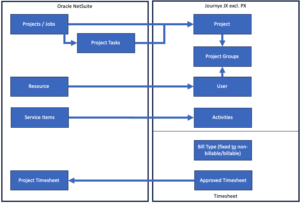Maximizing Efficiency: ERP Integration with Time Tracking Solutions
Understanding ERP Integration with Time Tracking
Integrating time tracking with your ERP system involves connecting your time tracking software with your enterprise resource planning (ERP) system. This integration allows for the seamless transfer of data between the two systems, ensuring accurate and up-to-date information on employee hours, project progress, and resource allocation.
By integrating time tracking with your ERP system, you can gain a comprehensive view of your organization’s operations. This visibility enables better decision-making and resource planning, as you have real-time insights into the time spent on various tasks and projects.
Additionally, ERP integration with time tracking eliminates the need for manual data entry and reduces the risk of errors or discrepancies. It automates the process of capturing and recording time data, saving valuable time and effort for your employees (and Journyx goes one step further by providing smart timesheets that basically fill themselves out!)
Understanding the fundamentals of ERP integration with time tracking is crucial for maximizing the efficiency of your business operations and optimizing resource utilization.
Benefits of Integrating Time Tracking with ERP
Integrating time tracking with your ERP system offers numerous benefits for your organization:
- Improved accuracy: By automating the time tracking process and eliminating manual data entry, integration with your ERP ensures accurate and reliable time data.
- Streamlined operations: Integration allows for real-time visibility into project progress, resource allocation, and employee hours, enabling efficient resource planning and task management.
- Enhanced productivity: With accurate time data, you can identify bottlenecks and optimize workflows, along with eliminating manual processes, leading to increased productivity, more timely project completion, and enhanced ROI for your time tracking and ERP systems.
- Cost savings: By tracking and analyzing time spent on various tasks and projects, you can identify inefficiencies and optimize resource allocation, resulting in cost savings.
- Compliance and reporting: ERP integration with time tracking facilitates compliance with labor regulations and enables easy generation of reports for payroll, billing, and project management purposes.
- Security and privacy: By using separate solutions, you can use your ERP seats for people who need to work in that system, while using time tracking licenses for all employees whose time you need to track. This might not only save you money, but also gives you a natural firewall for security purposes, ensuring that people only have access to the system (and data) that they need.
By leveraging the benefits of integrating time tracking with your ERP system, you can streamline operations, improve productivity, and drive business growth.
Challenges to Overcome in Integrating Time Tracking with Your ERP
While integrating time tracking with your ERP system offers significant advantages, there may be challenges to overcome:
- System compatibility: Ensuring compatibility between your time tracking software and ERP system is crucial for successful integration. You may need to evaluate and select compatible solutions or customize existing systems.
- Data synchronization: Achieving seamless data synchronization between time tracking and ERP systems can be complex, especially when dealing with large volumes of data. It requires careful planning and implementation. Ensure that you have—or someone on your core team has— a clear understanding of your ERP data objects and processes to be able to identify the critical data that needs synchronization.
- User adoption: Successfully integrating new systems requires user buy-in and training. Employees may resist change or struggle to adapt to the new processes. Effective change management strategies are essential.
- Security and privacy: Integrating systems involves sharing sensitive data, so robust security measures must be in place to protect confidential information.
By proactively addressing these challenges, you can ensure a smooth integration process and reap the benefits of time tracking and ERP integration.
How to be Successful in Integrating Your Critical Business Systems
Integrating critical business systems like time tracking and ERP requires careful planning and execution. Here are some key steps to ensure success:
- Define your objectives: Clearly define your integration goals and identify the specific benefits you aim to achieve through the integration.
- Involve the right players early: By creating your integration team early in the process, you can ensure that all key stakeholders get their needs met and help you keep the project on track.
- Get granular: decide which data objects are necessary for the first phase of implementation. This mapping process will be critical in determining if any customization is necessary. Also determine what elements are “Have to Have” items and which are “Nice to Have” items that may be pushed to the next phase after the initial rollout (refer often to objectives defined in Step #1).
For example, this diagram depicts the data objects in the standard integration between Journyx Project Time Tracking and Oracle NetSuite, to start the discussion:

- Plan data synchronization: Develop a strategy for synchronizing data between the two systems. Which is your primary system of record? Determine the frequency and granularity of data transfers to ensure accurate and up-to-date information.
- Sandbox accessibility: Give your time tracking integrations team access to your sandbox for building and testing scenarios using your data and workflows.
- Create all testing scenarios: While your time tracking vendor is building and testing the integration in your sandbox, create all the scenarios you want your team to test before go-live. Have each department create scenarios based on their given roles, such as:
- Create a user
- Create a project
- Create a project group
- Create a timesheet
- Approve a timesheet
- Reject a timesheet
- Assign users to projects
- Delete a user
- …etc.
- Determine access and permission levels: If these are a part of your ERP already, will those be carried into your new time tracking system? Will you need new access and permission levels?
- Test and refine: Ensure that your team has the testing scenarios and permissions necessary to conduct thorough testing of the integration systems to identify, report on, and resolve (where possible) any issues or discrepancies. Continuously monitor and refine the integration to optimize performance. Plan for two weeks of testing by your team upon delivery of the vendor-tested solution. While it’s easy to go beyond that timeframe, we’ve seen the greatest success with customers who test extensively in that concentrated time period so you can back to your regular jobs as quickly as possible. Ensure that any issues identified are in the Scope of Work document to mitigate “scope creep” and keep the project on time and on track.
- Implement change management: Prepare your employees for the integration by providing training and support. Clearly communicate the benefits of integration and address any concerns or resistance. Lean on your integration team to help you with this.
- Debrief and next steps: Re-assemble integration teams to determine what worked, what could’ve been improved, and what the next steps are based on these outcomes.
By following these steps and leveraging the expertise of your vendor implementation team, IT team, and/or consultants, you can successfully integrate your critical business systems and maximize efficiency.
Best Practices for Successful ERP Integration with Time Tracking
To ensure a successful ERP integration with time tracking, consider the following best practices:
- Define clear objectives and measurable goals for the integration.
- Involve key stakeholders from different departments to ensure alignment and gather diverse perspectives.
- Conduct thorough research and evaluation of potential software solutions to find the best fit for your organization’s needs.
- Establish a robust data management and security framework to protect sensitive information.
- Regularly communicate and provide training to employees to facilitate smooth adoption of the integrated systems.
- Continuously monitor and evaluate the integration’s performance, making necessary adjustments and refinements.
By adhering to these best practices, you can optimize the benefits of ERP integration with time tracking and drive operational efficiency for your business.
To learn more about integrating Journyx time tracking solutions with your ERP, feel free to access the following resources:
Let’s Get Started. Book a Demo Today.
Journyx helps you track time for projects, payroll, and more. Learn how Journyx can help you use time to your advantage in your business.



